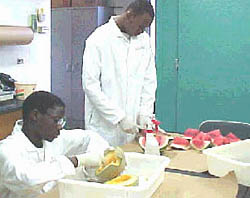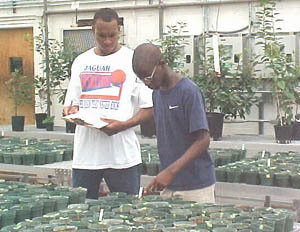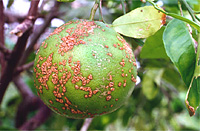By Kisha Shelton,
Plant Pathology Department, University of Georgia
"At the beach, camping, hanging out with my friends," these are typical answers you would expect from teenagers when asked that familiar question "So what did you do on your summer vacation?" These answers changed for two groups of high school students in Georgia. Some of the students within those two groups can respond with either "I worked on a plant disease" or "I visited the Plant Pathology Department at the University of Georgia". The campus of the University of Georgia hosted two new programs this year: the College of Agricultural and Environmental Sciences Summer Internship Program and the Georgia Plant Science Scholars (GAPSS).
The CAES-Summer Internship Program placed many local high school students with CAES faculty to experience the world of agricultural research. Two of these students, Travis Lester and Nkaku Kisaalita, worked with Assistant Professor Ron Walcott in the Department of Plant Pathology’s Seed Pathology Laboratory. Lester and Kisaalita spent six weeks working on a project involving the biological control of watermelon fruit blotch (Acidovorax avenae susp. citrulli). The project involved greenhouse and laboratory experiments. Lester and Kisaalita rated watermelons (some seeds were treated with a biological control while others were not treated with a biological control) for development of fruit blotch. Their laboratory work showed some promise as the two found some initial indications of at least two bacterial biological controls for fruit blotch.
 |
Travis Lester (on right) and Nkaku Kisaalita extracted seeds from watermelons and cantaloupe as part of their research project on biological control of fruit blotch.
|
The two students learned that research has both positives and negatives as they discovered that conditions for the greenhouse experiment were not quite right. When asked what they would do differently both replied that they would find a greenhouse that offered warmer conditions so their biological control would have an optimum growing environment. While working on their project, they had also the opportunity to assist in other projects in the laboratory. On July 21, Lester and Kisaalita presented their findings "Bio-control of Fruit Blotch of Watermelon" to their fellow students taking part in the internship program and to faculty and staff of CAES.
 |
Travis Lester (on left) and Nkaku Kisaalita rated seedlings in greenhouse experiments in order to determine the effectiveness of potential biological control agents for fruit blotch of watermelons.
|
When asked what they thought of the program, both said that they enjoyed the experience and gained a new appreciation for agricultural research. Lester felt that he obtained a new and better understanding of Plant Pathology. Kisaalita said he gained new knowledge of a scientific laboratory and an appreciation for research. Both students said they would encourage fellow students to join this program next year, and both said they definitely would like to return next year for the program in order to gain more experience.
Another group of students visited UGA this summer was the Georgia Plant Science Scholars (GAPSS). Eleven juniors, seniors, and college freshmen joined the UGA-CAES Departments of Crop and Soil Sciences, Horticulture, and Plant Pathology and the College of Arts and Sciences Department of Botany for two days of "Fillin’ in the GAPSS for the Future". The eleven students, Krisda Chaiyachati, Kelli Clifton, John A. Craven, Karah Cripe, Justin D. Gage, Yavonda Haynes, Tara O’Shea, Beth Palmer, Jilinah Thomas, Rishi S. Vasudeva, and Macie Wing, represented various high schools throughout Georgia. GAPSS was created to introduce students to the world of plant science and to the future that awaits them in this world. Students received tours of campus, the Georgia State Botanical Gardens, research farms and the hosting departments. Students also participated in different hands-on activities dealing with aspects of each department. The tour through Plant Pathology was hosted by John Sherwood (Virology), Ron Walcott (Bacteriology), Charles Mims (Mycology), Dick Hussey (Nematology) and Taft Eaker (Homeowner Turf Problems). Students had the opportunity to meet and discuss with each faculty member different aspects of their expertise. Students visiting Walcott were able to observe different types of bacterial plant pathogens and were able to be present when watermelon infected with fruit blotch were cut open. Sherwood discussed viruses and as a special treat also discussed a plant infected with Aster Yellows Phytoplasma on loan from C. J. Chang. Hussey shared his knowledge of nematodes as students looked through peanut, tomato, and cotton roots to find root-knot nematode (RKN) galls. Students also used dissecting scopes to observe live RKN and soybean cyst nematode juveniles. To end the tour, Jan Fowler (Extension Diagnostician) taught the students how to make wet mounts used in diagnosing certain fungal diseases. Each student had the opportunity to make a wet mount of hollyhock rust to observe teliospores.
Following the tours of each department, the students and parents met with various industry representatives and CAES faculty and staff. The industry representatives took this time to discuss future careers awaiting the students in the world of plant science. The GAPSS Class of 2000 left campus with a better understanding of Plant Pathology as well as other aspects of plant science and maybe even with some goals
 |
Views: Recent outbreaks of citrus canker in lime groves in the Miami, Florida area have been reported by the news media. Although the disease is not a health threat to humans, it is of great concern to the citrus industry. Click here for more information.
|
